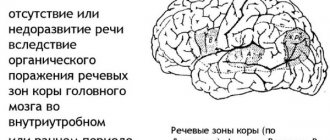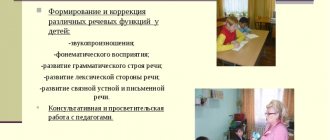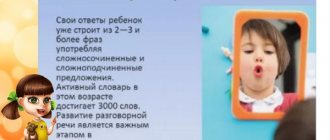3. Mechanism of development of stuttering
A complex and not fully established process. It is believed that under the influence of causes or provoking factors, Broca's center is overexcited, and its tone increases. Therefore, the speed of his work increases, and the speech circle opens. Next, overexcitation is transferred to areas of the cerebral cortex that are located nearby and are responsible for motor activity. This leads to muscle spasms occurring in the peripheral part of speech (tongue, lips, soft palate and others). Then Broca's center relaxes again, closing the speech circle. That is, a person begins to stutter due to a sudden disruption of the coordinated functioning of the speech organs when pronouncing sounds, which is caused by a spasm that occurs in one of the parts of the speech apparatus (tongue, palate, and others). It is noteworthy that both muscle spasms involved in the formation of sounds and breathing muscles can occur. As a result, not only stuttering develops, but also breathing is impaired (a feeling of lack of air appears). Stuttering mainly occurs on consonants, and less frequently on vowels. Moreover, hesitations most often occur at the beginning or middle of speech.
5.Stuttering in children
Most common. In general, the peak onset of the disease occurs in preschool age. The fact is that a child is born with underdeveloped cerebral hemispheres and cerebral cortex. Only by the age of five are they fully formed. Also, in young children, excitation processes predominate over inhibition processes. Therefore, excitation is easily transferred from sensory fibers to motor fibers. As a result, reactions in the form of a “short circuit” sometimes develop. In addition, the movements of the organs of articulation (tongue, lips and others) in babies are weak and insufficiently elastic, and their work is poorly coordinated. Hearing plays a leading role in the formation of speech, beginning to function from the first hours of a newborn’s life. However, children do not realize the difference between the sounds, syllables and words of those around them. Therefore, they understand speech poorly, mixing one sound with another. In addition, between the ages of 2 and 4 years, the child develops intensively and actively develops sound pronunciation and speech in general. However, at this age the speech function is not yet sufficiently formed. Therefore, the load on the nervous system increases, and its functioning may fail. It is these factors that explain the instability of the child’s speech and the high probability of developing speech disorders.
6. Risk factors for the development of stuttering in children
They only create the preconditions for the formation of stuttering. Emotionally labile nervous system
Babies are whiny, they have increased irritability, restless sleep and poor appetite, they are attached to their mother. A sharp change in environment can provoke the development of stuttering in children: starting to attend kindergarten, moving, a long absence from their mother, and so on. Early onset of speech At one year of age, children have a large vocabulary (normally, a baby correctly pronounces only 3-5 words). Subsequently, such children quickly increase their vocabulary: at 1.5-1.8 they already speak in expanded phrases or whole sentences. In this case, the baby loses his breath while pronouncing a long phrase. After all, he wants to tell everything at once. However, his tongue and lungs cannot yet cope with such a volume of speech. Late onset of speech The first correctly pronounced words in such children appear only at two years of age, and detailed phrases - no earlier than three years. Stuttering is caused by motor disinhibition of the nervous system. Therefore, babies often speak slurredly and pronounce sounds poorly. Stuttering in one of the family members. The child imitates his parents, brothers or sisters. Insufficient emotional contact between the child and others. Children do not receive enough affection and warmth. Adults do not listen to the baby, being busy with their own affairs. As a result, the baby feels unnecessary, so he may start to stutter so that his family will pay attention to him. Excessively strict attitude of adults towards children Dads are often the “sin” of this. Life is strictly on schedule: getting up, going to sleep, the barracks system of punishment, and so on. As a result, the baby grows up fearful and repressed, and is also afraid to make an independent decision so as not to anger the parent. Peculiarities of speech development At the age of 2 to 6 years, children often repeat or stretch out words and syllables, and sometimes insert extra sounds that carry neither semantic nor emotional meaning (“well,” “a,” “here,” and so on) B As a result, this habit is reinforced, creating the preconditions for the development of stuttering. Physical condition of the child Frequent colds, the development of allergic reactions, and the presence of congenital pathology push the baby to the realization that he is “not like everyone else.” Because there are often restrictions. After all, my mother constantly tells me: “Don’t eat orange/chocolate, because the rash will appear again,” “You can’t play in the yard, you’ll catch a cold,” and so on. As a result, the child withdraws into himself. In addition, frequent visits to medical institutions lead to the development of “fear of the white coat.” Mastering two or more languages at the same time Especially if parents speak different languages at home. In this case, the coordinated work of speech motor centers is disrupted. Because the baby is not yet fluent in his native language. Excessive demands on a child Sometimes parents want to demonstrate the extraordinary abilities of their child to all their acquaintances and friends. Therefore, they are forced to memorize complex poems and recite them at a birthday party or other family celebration. Whereas in the baby, the corresponding areas of the brain have not yet matured, and the muscles of the articulatory apparatus are not ready for such a load. Gender: Boys are more likely to develop stuttering than girls. Since girls develop motor functions in a shorter time: they begin to walk and talk earlier, and their motor skills (movement) of their fingers are better developed. Apparently, this is why girls’ nervous systems are more resistant to various factors that provoke the development of stuttering. Left-handedness
The harmonious interaction between the symmetrical structures of the brain of the right and left hemispheres is weakened. Therefore, the child’s nervous system becomes more vulnerable, which is reflected in the development of speech. Moreover, the risk of developing stuttering increases if they tried to retrain a left-handed child to use his right hand using crude methods. Hereditary predisposition Probably, the weakness of some brain structures that are involved in the formation of speech is inherited.
6.1 Reasons for the development of stuttering in children
There are several groups, but the reasons can often be combined. Condition of the central nervous system Children who have suffered diseases affecting the nervous system are prone to the development of stuttering: intrauterine hypoxia, trauma during childbirth, traumatic brain injury, infectious processes (caused by viruses, protozoa, bacteria, fungi) and other pathologies. After illnesses, there are residual effects that lead to structural changes in the brain (organic damage). As a result, insufficiency of the motor parts of the brain (for example, Broca's center) develops to varying degrees of severity. Therefore, the transmission of nerve impulses to the muscles from the central parts of speech is disrupted. While smooth speech requires coordinated work and maturity of the central nervous system. Such children are emotionally labile, impressionable, they have an increased level of anxiety, they do not adapt well to new conditions (for example, starting to attend kindergarten), they are timid, worried, and so on. Past mental trauma
Under the influence of stress, the coordinated redistribution of muscle tone involved in speech production is disrupted. That is, the muscles contract and relax inconsistently. Therefore, convulsive repetitions of sounds, syllables and words occur. Moreover, stress can be chronic or acute (fright, constant fear, death of a loved one, family troubles, etc.), and the strength of its impact does not matter.
Modern methods of stuttering correction
The formation of a modern integrated approach to the correction of stuttering was preceded by the development of various methods and ways to overcome this disease.
Despite the centuries-long history of studying and treating speech disorders, stuttering is one of the diseases whose mechanisms have not yet been fully studied and explained. It should be noted that the mechanisms of stuttering are heterogeneous. In some cases stuttering is interpreted as a complex neurotic disorder, which is the result of a “collision” of nervous processes in the cerebral cortex, a violation of cortical-subcortical interaction, a disorder of the single auto-regulated tempo of speech movements (voice, breathing, articulation).
In other cases - as a complex neurotic disorder, which was the result of a fixed reflex of incorrect speech, which initially arose as a result of speech difficulties of various origins.
Thirdly, as a complex, predominantly functional speech disorder that appeared as a result of general and speech dysontogenesis and disharmonious personality development.
Fourthly, the mechanism of stuttering can be explained by organic lesions of the central nervous system. Methods for overcoming stuttering were developed by the authors based on their different understanding of this speech disorder. The numerous methodological approaches to overcoming this pathology are explained by the complexity of its structural manifestations and the insufficient level of knowledge about its nature. The need for complex interventions in the correction of stuttering was pointed out by I.A. Sikorsky (1889) and I.K. Khmelevsky (1897). They expressed views that have not lost their significance today. So, I.A. Sikorsky included speech gymnastics, psychotherapeutic, pharmaceutical treatment and motor exercises in the treatment of stuttering.
Based on the teachings of domestic physiologists I.M. Sechenov and I.P. Pavlov and their followers, scientists and practitioners have defined a modern comprehensive approach to overcoming stuttering. L.Z. Andronova (1993), N.M. Assatiani (1980), V.A. Gilyarovsky (1932), K.M. Danilov and I.V. Cherepanov (1970), V.S. Kochergina (1960), V.A. Kurshev (1973), employees of the laboratory of the Research Institute of Defectology under the direction of R.E. Levina (1963), S.S. Lyapidevsky (1960, 1963), L.Ya. Missoulin (1988), Y.B. Nekrasova (1984), V.I. Seliverstov (2000), M.V. Serebrovskaya (1925), N.P. Tyapugin (1966), Yu.A. Florenskaya (1949), M.E. Khvattsev (1959), V.M. Shklovsky (1994), A.V. Yastrebova (1963) and others with their research contributed to the development of a therapeutic and pedagogical approach to overcoming stuttering. In the works of many authors there are instructions on some specific issues of eliminating stuttering (G.I. Angushev, 1974; S.Yu. Benilova, T.S. Reznichenko, 2001; T.G. Vizel, 1997; V.A. Kovshikov, 1976 ; Y.I. Kuzmin, 2000; V. Adamczyk, 1969; G. Andrews et al, 1982; S. Van Riper, 1982, etc.). In a number of foreign works we find interesting observations and recommendations regarding the correction of stuttering. Many clinical researchers come to the conclusion about the need for comprehensive comprehensive treatment of this speech defect, which includes speech therapy exercises, drug therapy, as well as targeted psychotherapeutic influence on the patient’s personality, helping him adapt to the conditions of the social environment (KP Bekker, M. Sovak, 1984; O.A. Bloodstein, 1995; M. Opslowsh et al., 1997; M. Seetan, 1962).
Scientific research based on experimental and clinical-psychological studies of people who stutter has made it possible to formulate valuable theoretical and practical principles and to determine the place of speech therapy and various therapeutic measures in a comprehensive treatment system. At present, there is no doubt about the advisability of a differentiated and individual approach to stutterers of different age categories, taking into account the complex structure and etiopathogenesis of speech disorders .
It should be noted that until now, researchers have expressed different and sometimes directly opposite points of view on this speech pathology. Most researchers and practitioners working on this problem are still of the opinion that it is necessary to comprehensively study and treat this speech disorder, and to select certain methods of complex therapy. In these conditions, there is a need to search for common conceptual foundations for the interaction of specialists and coordinate their activities.
In the rehabilitation of people who stutter, an integrated approach is currently used, since impaired speech fluency is associated with a number of reasons, both biological and socio-psychological.
Firstly, it is a combination of correctional pedagogical and therapeutic work, which is aimed at normalizing all aspects of speech, motor skills, mental processes, educating the personality of a stutterer and improving the health of the body as a whole. Secondly, an integrated approach includes a system of clearly demarcated, but coordinated means of influence by different specialists. This involves the joint work of a doctor, speech therapist, psychologist, rhythm specialist, functional diagnostics specialist, physiotherapist and social worker. Currently, the specialized literature presents both some methods of speech therapy work with people who stutter (covering only certain aspects of the problem that interests us), as well as a number of complex rehabilitation systems, the conceptual basis of which is to take into account the characteristics of the patient’s psychophysical development, the etiology, mechanisms and symptoms of the disorder, including speech disorders. , psychological, motor, age characteristics of this patient population.
According to L.I. Belyakova, E.A. Dyakova (1998); V.A. Kovshikova (1976); M.I. Lokhova, Yu.A. Fesenko (2000); V.M. Shklovsky (1994) and others, when developing rehabilitation measures, the nature of the primary damage to the nervous system in various forms of stuttering should be taken into account. In the neurotic form of stuttering, therapeutic interventions should be aimed at reducing the excitability of emotiogenic brain structures, which can be achieved through a combination of medications and various psychotherapeutic techniques (stress therapy, hypnosis, autogenic training). Speech therapy classes against this background are much more effective.
People who stutter with a neurosis-like form of speech defect require long-term correctional and pedagogical interventions that promote the development of regulatory functions of the brain (stimulation of attention, memory and other mental processes), and special drug treatment aimed at reducing the consequences of early organic brain damage. Speech therapy sessions for this group of stutterers should be regular over a considerable period of time. The complex of therapeutic and psychological effects necessarily includes methods aimed at rhythmizing movements.
Thus, according to the authors, in cases where the neural mechanisms of stuttering are associated with organo-functional damage to the motor structures of the brain, normalization in the functional speech system should occur through the development of new speech motor reflexes, while in neurotic stuttering treatment is aimed at restoration and strengthening of existing speech motor automatisms acquired in early speech ontogenesis. In connection with the tasks of diagnosis and pathogenetic substantiation of complex logotherapy V.M. Shklovsky (1994) proposed a classification of patients with stuttering, in which, along with the manifestation of speech pathology itself, the degree of disorganization of personality relationships is taken into account. This differentiated approach to adult stutterers made it possible to clearly define the place of speech therapy and various psychotherapeutic measures in the complex system of stuttering treatment . The complex medical and pedagogical system for the treatment of stuttering developed by the author most fully takes into account the various aspects of the clinical and psychological picture of stuttering. Such an assessment of the etiopathogenetic basis of stuttering largely reveals the essence of the problem and directs specialists to a comprehensive approach in the correction of speech disorders. In our opinion, based on the focus of this manual, we should dwell in more detail on the features of correctional and pedagogical work in the treatment of stuttering .
Since people who stutter have specific disturbances in the fluency of speech, features of its tempo-rhythmic organization, as well as changes in the motor sphere relating to dynamic praxis and musical-rhythmic abilities, this necessitates the formation of a rhythmic-intonation organization of oral speech, which is one of the important links in a complex method of stuttering correction.
Researchers and practitioners have noticed that rhythmization of movements leads to normalization of fluency of speech. To develop unity of speech in people who stutter, various methods are used to rhythmize speech: pronouncing words, phrases to music, a metronome, singing, training speech in the process of speech therapy rhythms, synchronizing speech with the movements of the fingers of the leading hand, etc. Classes with musical accompaniment with rhythmic movements of the arms, legs, torso, and subsequently the combination of these movements with singing, melodic recitation, reading poetic and prose texts optimize the flow of speech utterance (L.Z. Andronova, 1993; L.I. Belyakova et al. , 1992; G.A. Volkova, 2003; E.V. Oganesyan, 1981; N.A. Rychkova, 1999).
According to N.A. Vlasova (1959), overcoming stuttering is most effective in the process of gradually developing speech from conjugate pronunciation to normal speech. IN AND. Rozhdestvenskaya (1960) offers a system of relaxing, breathing, and vocal exercises in a playful form, as well as tasks for developing speech coordination with various movements aimed at correcting the tempo of speech. The author attaches leading importance to this aspect of the work. Developing the above provisions, E.Yu. Rau (1994) examines the dependence of the severity of stuttering on communication conditions and the ways in which stutterers adapt to difficult communicative situations.
G.A. Volkova (1979, 1994) believes that when working with preschool children attending speech therapy kindergarten, stuttering must be overcome through play activities. The author emphasizes that gaming activities make it possible to create various situations that reflect real events and relationships between people. Participation in a variety of game situations, playing roles from secondary to leading, develops the necessary personality qualities in people who stutter. In the process of differentiated use of play activities, the personal deviations of stuttering children are corrected and, on this basis, their speech is developed.
N.A.’s methodology is based on slightly different theoretical positions. Cheveleva (1978). The author believes that it is necessary for stutterers to develop only independent speech (situational and contextual) in the process of manual activity. The author does not consider it necessary to use breathing, vocal and other exercises aimed at correcting the rate of speech. ON THE. Cheveleva emphasizes that a calm, somewhat slow pace of making crafts normalizes the rate of speech of preschoolers and schoolchildren. Speech education using this method takes place in several stages: propaedeutic stage, accompanying speech based on visual objects and actions, final speech about a completed action, preliminary speech without reliance on a past action, consolidation of active speech or contextual speech.
M.I. Gerkina (1972), as well as later E.M. Pellinger et al. (1995), taking into account the situational nature of stuttering and the disruption of the communicative function of speech in children, proposes a method of story games. The correction begins with playing out stories with an imaginary interlocutor, which, according to the author, gives the installation of correct speech behavior in real situations of communication with peers. At the next stage, everyday themes are played out, and at the end of the course they move on to role-playing games. The speech therapist suggests the plot of the game, directs the action, and stimulates speech activity. A.V. Yastrebova (1999) developed a system of correctional education for stuttering schoolchildren, which provides, in the process of speech therapy classes, the formation of their free communication skills, the development of observation, sustained attention, and the ability to switch quite easily and quickly from one type of activity to another.
A.I. Bogomolova (1977) argues that the importance of neurotic manifestations in people who stutter is exaggerated. According to the author, as speech improves during speech therapy sessions, secondary neurotic layers disappear. Hence the focus of speech therapy techniques based on scanned speech exercises, which should be accompanied by conducting movements of the patient’s hand. It is difficult to agree with the author’s statement that the characteristics of the course of the disease in preschoolers and adolescents are based only on the long experience of stuttering in children of senior school age.
T. Verendes (1963) in his method of overcoming stuttering suggests using the “scene test” of G. Staabs. In the scenes (games) that the child builds with the help of dolls, the hidden conflict situation is revealed and at the same time mental tension is released. To enhance the impact and relieve psychophysical stress, the author suggests including autogenic training exercises and revealing subconscious experiences in hypnosis. Methodology V.I. Seliverstova (2000) is primarily designed for working with children in medical institutions. In the lesson plan proposed by the author, speech exercises become more complicated depending on the varying degrees of independence of speech, its preparedness, structural complexity, and the types of activities during which verbal communication occurs.
I.Yu. Abeleva (1969), as well as V.I. Seliverstov (2000), recommends starting work with preparatory exercises on speech technique: breathing, voice, articulation. Speech exercises for stuttering correction are based on the principle of gradually increasing the complexity of speech components. The literature on the problem of stuttering in adolescents and adults contains programs that highlight the most general views on eliminating stuttering. All modern systems of speech therapy classes with stuttering adolescents and adults are united by the presence in them (in addition to progressively more complex speech exercises) of various methods of psychotherapy, physiotherapy, and drug intervention.
The issue of using autotraining in the treatment of stuttering was developed by S.M. Lyubinskaya (1970), L.Ya. Missulovin (1988), Yu.B. Nekrasova, S.F. Orlovskaya (1966), V.M. Shklovsky (1979, 1994). What is common in the works of these authors is that autogenic training is recommended to be used in a complex of therapeutic and correctional measures along with other methods of psychotherapeutic influence.
The work of V.M. is specifically devoted to the issue of using various methods of group psychotherapy in the treatment of adults who stutter (discussion, nonverbal communication, projective drawing, sociometry, etc.). Shklovsky, L.M. Krolya, E.L. Mikhailova (1985).
One of the most famous methods of psychotherapy in the 50-70s, as B.D. points out. Karvasarsky (1990), is a group session of emotional stress therapy with elements of imperative suggestion according to K.M. Dubrovsky (1966). During the session, the patients’ negative emotions associated with fear of speech are contrasted with the life-affirming emotions of new psychological attitudes. In relation to stuttering, the technique was studied by Yu.B. Nekrasova (1984), which points to the possibility of changing the patient’s attitude towards suffering in a short period of time. In her opinion, the totality of mental states induced during a session of emotional stress psychotherapy causes new sthenic states in people who stutter: activity, readiness to overcome the psychological barrier and speak in extreme conditions.
V.M. Shklovsky (1994) introduced a session of suggestion while awake into the course of complex treatment of stuttering as a powerful psychotherapeutic technique aimed at eliminating patients’ fear of speech in emotionally significant situations. He also described in detail the methodology for conducting sessions, which provides for long-term consolidation of the results achieved during the session. Speech exercises in systems of logopsychotherapeutic sessions with people who stutter are based on methods generally accepted in speech therapy, taking into account the age characteristics of patients.
Many researchers who have studied tempo-rhythmic speech disorders (in particular, stuttering) note the important role of changes in the prosodic side of speech in the structure of speech disorders (Max L., Cariso A., 1997; Opslow M., et al., 1997). Researchers indicate that these characteristics can change under the influence of training.
According to M. Zeetan (1962), consciously slowing down the rate of speech is the basic principle of all corrective measures, despite their apparent diversity. When speech slows down in people who stutter, the correct coordination of respiratory, vocal and articulatory movements is established, and muscle tension and cramps are significantly reduced.
Statistical analysis of various treatment programs by G. Apdrews et al. (1982, 1983) is quite consistent with this view. The authors believe that the most favorable results are achieved by those stuttering correction programs that involve training in slow speech. Some researchers consider slowing down the rate of speech not only necessary, but also a sufficient therapeutic effect (R. A. Resick, P. Wendiggensen, S. Ates, V. Meyer, 1975). I.A. Povarova (2000, 2001, 2002) believes that a violation of the tempo-rhythmic parameters of speech is one of the leading components in the structure of stuttering and is characterized by polymorphism, persistence and variability of manifestation. Features of tempo-rhythmic characteristics of speech in people who stutter depend on the form of speech, the severity of the disorder and individual psychological status and are manifested in changes in the duration of structural segments of the speech signal and their coefficient of variation. The dynamics of these indicators makes it possible to predict the result of speech therapy and the choice of correction methods. It should be noted that an integral part of every speech therapy method for stuttering correction is work on intonation. Some authors consider it necessary to develop emotional, expressive speech in people who stutter from the very first lessons. This approach is followed by M. Zeman (1962), who has a negative attitude towards monotonous and monodynamic speech.
AND I. Yastrebova (1962, 1999) suggests focusing work on intonation on developing the ability to listen to someone else’s speech and convey the appropriate intonation in one’s own speech. Expressive speech requires the stutterer to be able to master different speech rates and voice modulations. At the initial stages of correction, students find it difficult to transfer the skill developed in classes in conditions of natural communication, therefore, a gradual path to mastering different tempos of speech is necessary for stutterers. Some experts suggest paying attention to working on intonation at the end of a course of speech therapy classes (A.G. Shembel, 1961), which contradicts the holistic formation of a functional speech system in the process of speech therapy work. Other authors recommend that stutterers use monotonous, monodynamic speech to help overcome speech cramps and ensure unity of speech. In this case, it is difficult to disagree with A. Liebmann (1901), who noted that artificial speech attracting the attention of others can “worse” a speech disorder. However, if we consider monotony as a means of reducing seizures, then it is probably necessary to use it at the first stage of speech therapy classes. The positive properties of monotony were also pointed out by I.A. Sikorsky (1889). The author found that monotonous speech is devoid of natural rises and falls in the tone of the voice. Such speech is one of the means that reduce stuttering very significantly; the transformation of natural speech into monotonous simplifies speech and facilitates the task of articulation for a stutterer.
Recommendations for improving speech tempo for both children and adults who stutter are contradictory. N.P. Tyapugin (1966) points out that treatment of stuttering at any age and in any period begins with re-education of the speech of a stutterer based on teaching him somewhat slow and smooth speech, which has regulatory significance. According to J. Brady (1969), by slightly slowing down the rate of speech, convulsions can be eliminated in almost any stutterer. The effectiveness of speech slowing techniques is also noted in the work of R. Resick (1975). However, there is another opinion regarding the formation of speech tempo in people who stutter. For example, L.N. Meshcherskaya (1982) believes that all known methods of eliminating stuttering are based on slowing down the rate of speech. The unnatural slow pace of speech and the fear of ridicule from others are the reasons for violating the recommended speech regime, which leads to relapses of stuttering. The author suggests working to overcome stuttering by forming a normal or close to normal speech rate.
Of interest is the opinion of individual authors regarding the tactics of forming the tempo of speech in people who stutter. Their recommendations boil down to the fact that after practicing speech skills using a slow speech rate, work should be done to speed it up. M. Seeman (1962) pointed out that all therapeutic exercises for stuttering are based on a single principle - a conscious change in the accent and tempo of speech in the first period of treatment and a gradual transition to normal speech.
The most detailed approach to overcoming stuttering in adult stutterers is described in the work of G. Apdrews, R. Howie (1981). Initial training is carried out at a speech rate of 50 syllables per minute, which, according to the authors, is approximately a quarter of the standard rate and is the optimal speed at which stuttering rarely occurs. Then gradually (within a week) the speech rate of stutterers increases to the norm. T.G. Wiesel (1997) believes that with all types of work to correct the fluency of phrasal speech, its pace should be normal and take into account the individual characteristics of the speed of pronunciation. At the same time, the author notes the need to gradually complicate the rhythmic and semantic structure of the phrases being practiced in accordance with linguistic patterns.
L.Z. Andronova (1993), taking into account the need to slow down the speech rate of people who stutter, believes that it cannot be imposed forcibly. Therefore, at the initial stage of treatment, she considers it appropriate to introduce syllable-by-syllable speech with external support (rhythmization of speech with movements of the fingers of the leading hand). A number of studies have shown that instrumental interventions used to correct stuttering affect speech speed in different ways. Silencing speech with noise has little effect on the temporal characteristics of the speech of people who stutter (O.V. Wessart, 1983). A delay in acoustic feedback leads to a significant slowdown in speech and a significant reduction in the number of stutters (N.I. Zhinkin, 1958; Yu.I. Kuzmin et al., 1991). L.Ya. Missulovin (1988) determined the indications for the use of the AIR apparatus, based on the use of the effect of delayed acoustic feedback, and proposed a method for correcting the tempo and rhythm of speech in the course of complex treatment of stuttering; the level of signal delay is determined in each specific case individually.
I.V. Danilov and I.M. Cherepanov (1970) investigated the influence of different metronome rhythms on the speech of stutterers and found that with the “tonic form of stuttering” the maximum increase in speech speed (by 83%) occurs at a frequency of 1 Hz (60 metronome beats per minute), and with the “clonic form of stuttering” "—at a frequency of 2.17 Hz (130 beats/min). According to M.I. Lokhova and Yu.A. Fesenko (2000) with a mixed type of stuttering, maximum speech coherence is achieved at frequencies of 1.3-1.5 Hz (80-90 beats/min), which is consistent with the data of other authors (Demuth et al. 1981).
L.Z. Andronova, M.I. Lokhov (1983) understand stuttering in accordance with the concept of N.P. Bekhtereva (1988) as a stable pathological condition. They have developed a method for the treatment of stuttering, which involves the destabilization of a stable pathological speech system by means of photophonostimulation against the background of the administration of subclinical doses of etimizol, the formation against this background of new stable rhythmically controlled connections and the use of a new functional state of the brain in order to assimilate speech therapy (in particular, suggestive) influences for formation of a new speech system. The frequency of phonostimulation is combined with the frequency of photostimulation, which is selected based on the data of the EEG reaction of the rhythm assimilation of a given patient.
Researchers studied the effects of rhythmic photostimulation on the speech of people who stutter, which was significantly improved by photostimulation at low frequencies (1.2-2.3 Hz). These data were obtained in a study of adult stutterers (L.Z. Andronova, M.I. Lokhov, 1983; M.I. Lokhov, 1994). Artificial control connections formed by a combination of light and sound influences are supported using portable metronomes “Ri. According to the authors, the use of a metronome at a code frequency protects speech from breakdowns and reduces the number of relapses. In the process of mastering new speech stereotypes, the development of the articulatory apparatus, mastery of rhythmic syllabic speech, relaxation of the body muscles and articulatory apparatus, elimination of accompanying movements, and mastering of psychotraining exercises are carried out, including elements of autogenic training against the background of a given rhythm.
Some researchers note that the introduction of simple metronomic feedback at a certain frequency, without complex equipment for analyzing EEG rhythms, also produces a significant positive effect (Armsop et al., 1997; Christenfeld, 1996).
G.I. Angushev (1974), studying the role of voluntary control of performed activities, obtained experimental data indicating a hierarchy of levels of self-regulation. The author pointed out that the difference between people who stutter and people without speech pathology lies in the nature of the relationship between two levels of regulation: voluntary (consciously controlled) and involuntary (unconsciously controlled). In people who stutter, regulation is carried out at a higher level than in healthy people. As a result, the process of automation of activity is complicated, which causes instability of dynamic stereotypes formed during the correctional pedagogical process and requires regular exercises.
In the process of stuttering correction, the leading role belongs to training aimed at developing a new stereotype of speech production. The work is carried out using various technical means. In pedagogical practice, since the 60s of the 20th century, the method of biofeedback (BFB) began to be used. The biofeedback method, based on the body’s self-regulation mechanisms, leads to the establishment in the central nervous system of new functional connections necessary to obtain the desired effect, which are consolidated during the learning process. Using this method, people who stutter are able to independently control and regulate individual parameters of their functions (breathing, voice production, etc.). Biofeedback, based on the transformation of a speech signal into a visual image, is effectively used in the process of comprehensive rehabilitation of people who stutter and has a positive effect on the process of speech formation (T.K. Korolevskaya, 1996; O.S. Orlova, 2003; I.A. Povarova, 1995, 2003; A.A. Smetankin, 1999, 2002, etc.). The issue of the effectiveness of complex treatment of stuttering is covered in the works of G.A. Volkova (1983); L.S. Volkova, S.N. Shakhovskoy (2002); ON THE. Vlasova, K.P. Becker (1983); V.G. Kazakova (1973); V.A. Kovshikova (1972); V.A. Kursheva (1973); M.I. Lokhova (1994, 2000); IN AND. Seliverstova (2000); V.M. Shklovsky (1967, 1994) and many other studies.
The ambiguity of researchers' views on treatment results is due to different approaches to determining assessments and criteria for the effectiveness of correction of this speech disorder.
The effectiveness of stuttering correction is determined by a number of factors: • the nature of the defect and the severity of its symptoms (speech, motor and neuropsychic characteristics); • timing of the start of corrective action and its duration; • complexity of impact; • the adequacy of the chosen methods of correctional influence, taking into account the age and psychological characteristics of students, etc.; attitude towards learning. The high plasticity of the central nervous system, the choice of the right means and methods of influence, and other factors determine the generally favorable prospects for the process of stuttering correction.
Thus, in matters of overcoming stuttering, researchers still express different points of view, of which, in our opinion, the most correct seems to be the one that provides for an integrated medical, pedagogical and psychological approach to the problem of rehabilitation of people who stutter. The material is taken from the book by Povarova IA “Correction of stuttering in games and training.”
7.Stuttering in adults
It occurs infrequently and, as a rule, begins in childhood. However, logoneurosis often appears in adults, causing the development of considerable problems: they withdraw into themselves, become timid and indecisive, avoid communicating with people, are afraid of public speaking, and so on. 8. Risk factors for developing stuttering in adults Male gender Men are more prone to developing stuttering than women. Professor I.P. Sikorsky explains this by the fact that in women the left hemisphere, in which Broca’s motor center is located, is much better developed than in men. Hereditary predisposition There is a congenital weakness of the central parts of speech, therefore, when exposed to unfavorable factors (for example, stress), their work is disrupted.
8.1 Causes of stuttering in adults
Stressful situations: the serious loss of a loved one, a road accident that happened before our eyes, military operations, an earthquake, disasters, and so on. Under the influence of stress, the coordination of the muscles responsible for producing sound is disrupted: they contract and relax inconsistently. As a result, muscle cramps develop. That is, there is a relationship with the emotional state of a person. Diseases of the central nervous system Traumatic brain injuries, previous neuroinfections (viral, bacterial, fungal, affecting the nervous system), encephalitis, meningitis and others. Because the transmission of nerve impulses from the brain along the nerve pathways to the muscles responsible for speech formation is disrupted. In adults, a major role in the occurrence of stuttering is played by previous strokes or the presence of brain tumors (benign, malignant), if the central parts of speech are affected. Because there is a mechanical obstacle to the transmission of nerve impulses. Moreover, in these cases there is no relationship between stuttering and emotional stress. That is, a person stutters at rest, alone with himself, when singing and talking in chorus.
9.Types of stuttering
They are divided according to the form of seizures, clinical manifestations and course of the disease.
Types of stuttering according to the form of seizures
- Clonic stuttering is when several short-term spasms following each other lead to the involuntary repetition of individual syllables and sounds.
- Tonic stuttering - if the muscles contract for a long time and strongly. As a result, speech delay occurs.
- The mixed form develops when both types of speech impairment are combined.
In addition, sometimes violent and involuntary movements (convulsions) of the muscles of the face and/or limbs join the spasms of the muscles of the tongue, lips and soft palate. Types of stuttering along the way
- Constant - stuttering, having arisen, is constantly present in all situations and forms of speech.
- Wavy - stuttering does not disappear completely: it appears and then disappears.
- Recurrent (recurrent) - a speech defect, having disappeared, appears again. Sometimes after quite long periods of speech without hesitation.
Types of stuttering according to clinical forms
There are two forms of logoneurosis: neurotic and neurosis-like. The separation is based on different causes and development mechanisms. Neurotic form Patients have no data on the presence of intrauterine hypoxia or birth injuries in the past. The impetus for the development of stuttering is mental trauma (acute or chronic stress) or the early active introduction of a second language of communication (at 1.5-2.5 years). That is, the disease is functional in nature, and the brain structures are not affected. Therefore, this form of stuttering is more treatable. Characteristics of children prone to developing a neurotic form of stuttering Initially, such children are timid, impressionable, anxious, touchy, irritable, whiny, afraid of the dark, do not stay in a room without adults, have difficulty getting used to a new environment, and sleep poorly. Their mood also changes quickly, and more often downward. Mental, physical and motor development in children corresponds to their age. However, their speech development occurs somewhat earlier: the first words appear by 10 months of life, phrasal speech by 16-18 months. 2-3 months after the start of phrasal speech, children are already constructing complex sentences and speech structures. The pace of speech is accelerated: children “choke”, do not finish words, miss prepositions and words. In addition, speech is sometimes slurred.
10.Symptoms
In children, the disease occurs suddenly, usually between the ages of 2 and 6 years. Immediately after mental trauma, which becomes the “last straw,” the child stops speaking for some time (mutism). At the same time, an expression of fear is “written” on his face. Then, when the child begins to speak again, he already stutters. The baby becomes irritable and whiny, sleeps poorly, and is afraid to talk. When a second language is introduced, the child experiences mental stress as the load on the speech apparatus increases. While some children, due to age characteristics, have not sufficiently mastered their native language. Stuttering in a baby intensifies when exposed to any stress, emotional tension or anxiety. That is, the course of the disease is wave-like: periods of stuttering alternate with light intervals when the child speaks without hesitation. Whereas if the baby is sick (his body temperature rises, he coughs, and so on), then his stuttering does not get worse. The neurotic form of the disease occurs both favorably and unfavorably. In the first case, a cure occurs, and in the second, the disease becomes chronic. In the chronic course of the disease, stuttering becomes more and more severe over time. By the age of 6-7 years, children are reluctant to talk to new people. And at the age of 11-12, children’s behavior changes dramatically: they withdraw into themselves. Because they are well aware of their defect and are afraid of making an unfavorable impression on their interlocutor. Children develop logophobia - a fear of conversation with an obsessive expectation of speech failures. That is, a vicious circle is formed: convulsive stuttering in speech leads to the emergence of negative emotions, and they, in turn, lead to increased stuttering. Neurosis-like form In patients from the anamnesis (data from the past), it turns out that the mother suffered severe toxicosis during pregnancy, there was a threat of miscarriage, asphyxia (suffocation) or trauma during childbirth, and so on. That is, there is organic damage to the brain (dystrophic changes in brain cells), so this form of stuttering is more difficult to treat. For the neurosis-like form of stuttering, the manifestations of the speech defect do not depend on external factors (for example, emotional stress). Characteristics of children prone to developing a neurosis-like form of stuttering In the first years of life, such children are noisy, sleep poorly, restless, and fussy. Their physical development is somewhat behind that of their peers. They have awkward movements and poor coordination, they are disinhibited and easily excited, irritable and hot-tempered. Children do not tolerate heat, travel and stuffiness well. They get tired quickly and are also exhausted during physical and/or intellectual stress. They have delayed speech development, the pronunciation of some sounds is impaired, their vocabulary accumulates slowly, and phrasal speech is formed late. Symptoms In children, stuttering begins at about the age of 3-4 years for no apparent reason, increasing gradually. The beginning, as a rule, coincides with the formation of phrasal speech. In the first half of the year of the disease, periods with stuttering gradually become longer and appear more often, and “light” intervals (when the child does not stutter) are not observed. That is, the disease proceeds on “one note.” Next, children begin to add extra phrases and words that do not carry a semantic load (embolophrasia): “a”, “e”, “well” and others. At the same time, the pace of speech itself is either accelerated or slowed down. As a rule, there is a sharp disturbance in breathing during speech: words are pronounced at the moment of inhalation or at the end of a full exhalation. In addition, there is insufficient mobility, as well as coordination of the organs of articulation (tongue, palate, etc.), arms and legs. Also, spasms can occur in the facial muscles of the face or hands. As a rule, such children develop a poor ear for music. Upon examination, it turns out that most children have organic brain damage of a residual nature. Therefore, children often have decreased memory and performance, they quickly get tired and suffer from headaches, they have attention deficit and hyperactivity. In adults with a chronic course of this form of the disease, there are often severe convulsions in all parts of the speech apparatus. As a rule, their speech is accompanied by nodding movements of the head, monotonous movements of the fingers, swaying of the body, and others. That is, there is a forced contraction of other muscle groups that have nothing to do with the formation of speech. In severe forms of the disease, adults become tired of communication, so soon after starting a conversation they complain of fatigue and begin to answer in monosyllables. In addition, adults find it difficult to adapt to new conditions, they have decreased memory and attention, increased fatigue and exhaustion. Classes with a speech therapist bring relief to most patients, but only if the work is carried out regularly and for a long time.
Stuttering, logoneurosis, hesitation in speech, dysrhythmia
Stuttering in children is a disorder of the tempo-rhythmic aspect of speech caused by repeated convulsions in the articulatory, vocal or respiratory parts of the speech apparatus. Stuttering in children is characterized by “getting stuck” on individual sounds, their repeated, involuntary repetition, accompanying movements, speech tricks, logophobia, and vegetative reactions.
Neurological therapy classes for the correction of stuttering in our center can be based on various author’s methods: Cheveleva, Vlasova and Rau, Shklovsky, Volkova, Mironova, etc. The main methods of speech therapy work for stuttering are breathing-vocal gymnastics, relaxation of tense articulatory muscles, speech exercises on rhythmization of speech, normalization of its tempo, development of expressive speech intonation, logorhythmic exercises.
Children with stuttering, logoneurosis, and even hesitations in speech must be examined by a neuropsychologist and speech therapist.
Competent correction of stuttering, which leads to sustainable results, must necessarily include a neurocorrectional set of measures (neuropsychological correction, neuroacoustic programs) and a system of “correct” speech therapy classes.
Stuttering in children is unintentional stops and hesitations in oral speech that arise as a result of a convulsive state of the speech muscles.
It must be remembered that in addition to speech spasms, stuttering in children is accompanied by a disorder of higher nervous activity, which in some cases may be associated with a neurotic reaction, in others with organic damage to the central nervous system. Therefore, it would be wrong to consider stuttering in a child as a purely speech problem; The study and correction of stuttering in children is impossible without the integration of knowledge from the field of neuropsychology and the development of brain areas.
This is where the root of problems with speech hesitations lies.
Depending on the pathogenetic mechanisms underlying stuttering, there are 2 forms of stuttering in children: neurotic (logoneurosis) and neurosis-like. Neurotic stuttering in children is a functional disorder; neurosis-like is associated with organic damage to the nervous system and brain.
In the most extreme cases, stuttering can make speech and communication nearly impossible. The severity of stuttering may vary for the same child in different situations.
Depending on the nature of the course, the following variants of stuttering in children are distinguished:
- wavy (stuttering increases and decreases in different situations, but does not disappear);
- constant (stuttering has a relatively stable course)
- recurrent (stuttering occurs again after a period of speech well-being).
Children who stutter often exhibit enuresis, night terrors, increased anxiety and vulnerability. Therefore, ignoring stutters and “running” this problem is DANGEROUS.
Perinatal brain damage in children can be associated with toxicosis of pregnancy, hemolytic disease of the fetus, intrauterine hypoxia and asphyxia during childbirth, birth injuries - and all this can subsequently lead to stuttering and hesitation in speech.
Children who are physically weak, with an underdeveloped sense of rhythm, general motor skills, facial expressions and articulation are more susceptible to the development of stuttering.
The increase in the incidence of stuttering is directly related to the introduction of computer games and various computer technologies into everyday life, which unleash a huge flow of audiovisual information on the fragile nervous system of children.
It should be remembered that the processes of maturation of the cerebral cortex and the formation of functional asymmetry in brain activity are generally completed by the age of 5, therefore exposure to any stimulus that is excessive in strength or duration can lead to a nervous breakdown and stuttering in children.
The immediate causes of stuttering in children also include immediate mental shocks or long-term mental trauma.
Stuttering in children can be caused by imitation of people who stutter, overload with complex speech material, and retraining to be left-handed. Experts point to the connection between stuttering in children and left-handedness and other speech disorders (dyslalia, tachylalia, dysarthria, rhinolalia). Secondary stuttering in children can occur against the background of motor alalia.
In the case of neurosis-like stuttering, which occurs against the background of organic damage to the central nervous system in the perinatal or early period of child development, the disorder develops gradually. Neurosis-like stuttering in children appears from the moment speech begins or at the age of 3-4 years, i.e. during the period of formation of phrasal speech.
Children with neurosis-like stuttering have impaired general motor skills : their movements are awkward, constrained, and stereotyped. Characterized by sluggish facial expressions and poor handwriting; Dysgraphia, dyslexia and dyscalculia often occur. The course of neurosis-like stuttering in children is relatively constant; Speech deterioration can be caused by fatigue, increased speech load, and somatic weakness.









